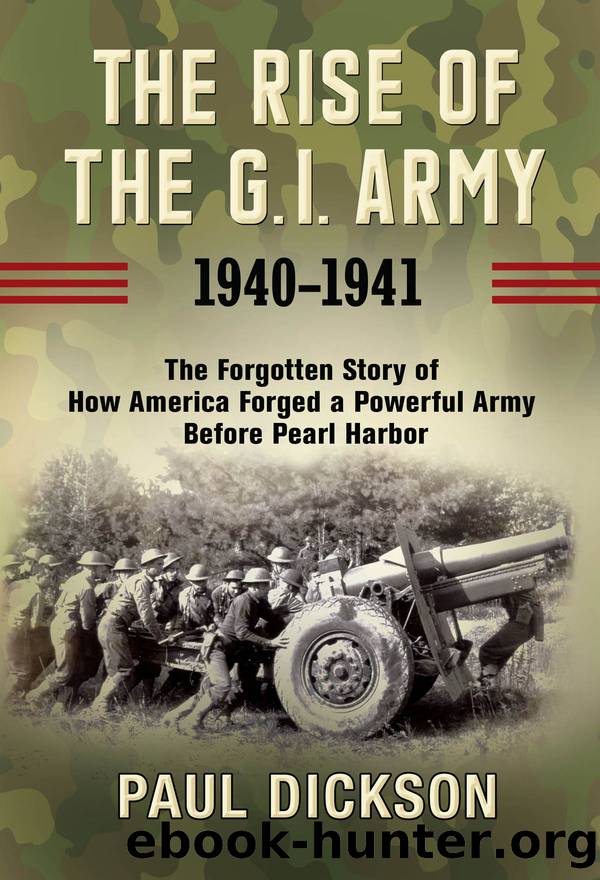The Rise of the G.I. Army, 1940–1941: The Forgotten Story of How America Forged a Powerful Army Before Pearl Harbor by Paul Dickson

Author:Paul Dickson
Language: eng
Format: epub
Publisher: Grove Atlantic
Published: 2020-06-26T00:00:00+00:00
The Red Army was fast losing ground, as Krueger’s forces now held Lear’s headquarters, and at 3:30 p.m. Central Time, McNair declared the battle over, as the momentum of Lear’s smaller army was stalled and unable to penetrate any deeper into Blue territory. The invading Second Army, Leon Kay reported, was “tired, hungry and confused as it lay down its arms Friday as the first phase of the mass maneuvers in Louisiana ended.”30
The New York Herald Tribune termed what had happened an “armistice victory” by the defending Blue Army, and the Associated Press termed it a “rout.” Many years after the fact, a scholar stated in his thesis on the subject: “Lear had started out hard and fast, but ended up cold.”31
Richard Hottelet, who reported from the Red Second Army for United Press, had just recently returned from Berlin and the European battlefields where he reported on the blitzkrieg from the German side. He noted that no official notification had been made by the umpires as to who “won,” but the Blue Army thought it was the clear victor over the tank-rich but smaller Red Army. Hottelet noted that a combination of terrain and tactics had stopped the tanks. The swamps and heavy rains that had fallen as the maneuvers began forced the tanks to keep to the main paved roads, which exposed them to dive-bomb attacks from the air and to nests of Blue Army snipers positioned along the main roads. “There was no opportunity for swift and dramatic dashes like the encircling movements of the German Panzer divisions I saw over the firm dry ground of Northern France,” Hottelet wrote, adding that when the Nazi tanks encountered flooded areas in the Netherlands, they simply drove around them.32
After the exercise ended, the Blue Army issued a communique claiming “an unquestioned victory,” to which the Red Army responded by saying: “Quick moves used to confuse an enemy do not constitute flight.” The Red Army blamed its showing on “Krueger’s 5 to 1 numerical advantage,” though the actual ratio (still consequential) was 1.7–1.
A few lessons appeared to have been learned—or at least underscored—during this exercise. Major General Charles L. Scott, commander of the First Armored Division, concluded that air superiority and a motorized infantry were needed for the success of tank attacks. “The day of trying to operate without aircraft is past,” he asserted. “And putting foot troops with tanks is like sending a race horse and a plow mule out together and expect them to go at the same speed.” Scott believed that Lear’s forces lost because the tanks had to wait for troops on foot to catch up, when they could have cut Krueger’s forces to shreds if they had just gone in.33
George Patton’s Second Armored Division had met with overpowering infantry and anti-tank opposition and was essentially destroyed. There was general agreement that the combination of inhospitable terrain, weather, unfavorable umpire rulings, and the anti-tank battalions had combined to defeat Patton’s men. Patton was not only frustrated to
Download
This site does not store any files on its server. We only index and link to content provided by other sites. Please contact the content providers to delete copyright contents if any and email us, we'll remove relevant links or contents immediately.
| Africa | Americas |
| Arctic & Antarctica | Asia |
| Australia & Oceania | Europe |
| Middle East | Russia |
| United States | World |
| Ancient Civilizations | Military |
| Historical Study & Educational Resources |
Magic and Divination in Early Islam by Emilie Savage-Smith;(1500)
Ambition and Desire: The Dangerous Life of Josephine Bonaparte by Kate Williams(1344)
Bohemians, Bootleggers, Flappers, and Swells: The Best of Early Vanity Fair by Bohemians Bootleggers Flappers & Swells- The Best of Early Vanity Fair (epub)(1343)
Papillon by Henry Charrière(1310)
Twelve Caesars by Mary Beard(1256)
Operation Vengeance: The Astonishing Aerial Ambush That Changed World War II by Dan Hampton(1136)
What Really Happened: The Death of Hitler by Robert J. Hutchinson(1128)
London in the Twentieth Century by Jerry White(1113)
Time of the Magicians by Wolfram Eilenberger(1089)
The Japanese by Christopher Harding(1086)
Twilight of the Gods by Ian W. Toll(1084)
Lenin: A Biography by Robert Service(1045)
The Devil You Know by Charles M. Blow(985)
A Social History of the Media by Peter Burke & Peter Burke(936)
Freemasons for Dummies by Hodapp Christopher;(922)
Napolean Hill Collection by Napoleon Hill(902)
Henry III by David Carpenter;(891)
The Churchill Complex by Ian Buruma(881)
The Rise and Triumph of the Modern Self by Unknown(879)
